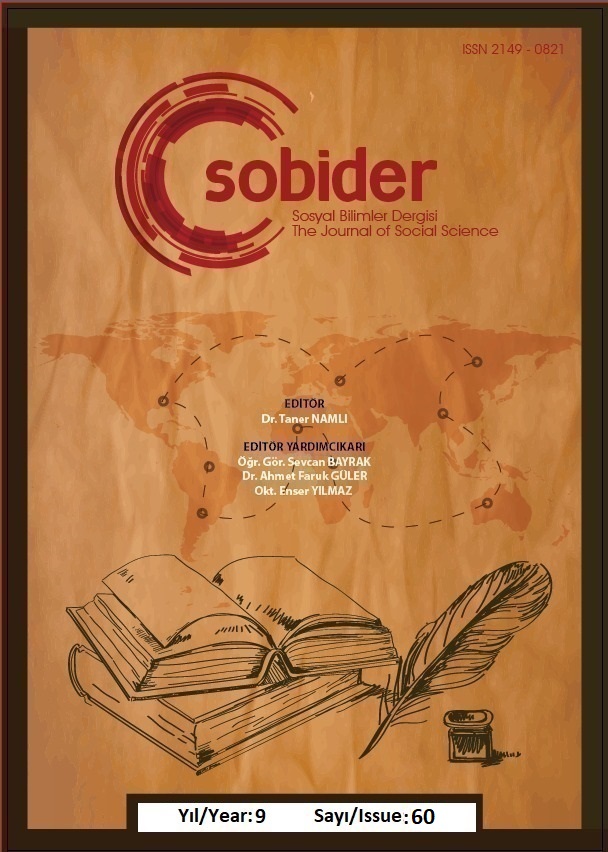Author :
Abstract
Günümüzde hemen hemen her sanat öğrencisi sanat eğitimi sırasında usta sanatçıların eserlerinden yola çıkarak gerçekleştirilen kopya yöntemini kullanmaktadır. Bu durum incelenen sanatçının renk, biçim ve tekniğine hâkim olma konusunda etkili bir yöntem olmanın ötesinde o sanatçının yaratmış olduğu eserin duygusunun da anlaşılması açısından etkili bir yöntemdir. Bunun en önemli örneklerinden birisini Diego Velazquez’in eserleri üzerine çalışmalar yapan Francisco Goya’da görmekteyiz. İspanyol saray ressamı olarak çalışan Romantizm akımı öncülerinden Goya’nın Kraliyet koleksiyonuna Velazquez'in eserlerinden bir dizi gravür yapılması görevi üzerine gerçekleştirdiği gravür baskıları bu araştırmanın ana konusunu oluşturmaktadır. Bu araştırmada Goya’ya ait “Velazquez’den Sonra” isimli baskıresim serinden seçili dört eser incelenmiş ve dönemin baskıresime bakış açısı, sanatçının yaşamı üzerinden betimsel bir analiz yapılmıştır. Sonuç olarak Goya’nın bu serisi onun hem Velazquez’in çalışmalarını daha yakından incelemesine fırsat sağlamış hem de gravür tekniği üzerinde ustalaşmasına büyük katkısı olmuştur. Dahası bu çalışmalar Goya’nın resimleri üzerinde Velazquez’in etkisinin bir kanıtı olarak görülmektedir.
Keywords
Abstract
Today, almost every art student uses the copy method, which is based on the works of master artists during their art education. This situation is not only an effective method for mastering the color, form and technique of the artist under study, but also an effective method in terms of understanding the emotion of the work created by that artist. We see one of the most important examples of this in Francisco Goya, who studies the works of Diego Velazquez. The gravure prints of Goya, one of the pioneers of the Romanticism movement working as a Spanish court painter, on the task of making a series of engravings of Velazquez's works for the Royal collection, constitute the main subject of this research. In this research, four selected works from Goya's printmaking series named "After Velazquez" were examined and a descriptive analysis was made on the printmaking perspective of the period and the artist's life. As a result, this series of Goya not only allowed him to examine Velazquez's work more closely, but also greatly contributed to his mastery of the engraving technique. Moreover, these works are seen as evidence of Velazquez's influence on Goya's paintings.
Keywords
- Akalan, G. (2000). Gravür. Ankara: Kaleseramik Sanat.
- Arısoy, D. & Kayahan, Z. (2022). “Monobaskı Üzerine Bir Uygulama Örneği”, International Social Mentality and Researcher Thinkers Journal, (Issn:2630- 631X) 8(62): 15281535.
- Askew, Mary Huneycutt (1988). The “ Caprichos” of Francisco Goya, Doktora tezi. Stanford University.
- Buchholz, E.L., Bühler, G., Hille, K., Kaeppele, S. & Stotland, I. (2012). Başvuru kitapları sanat (D.N. Özer, Çev.). İstanbul: NTV.
- Calosse, von Jp. A. (2011). Goya (eBook). New York: Parkstone Press USA.
- Carl, H. (1985). Colour etching 80 examples northhern bavarian artists. Nürnberg: Hans Carl.
- Chamberlain, W. (1984). Etching and engraving. London: Thames and Hudson.
- Cirlot, L. (2007). Francisco de Goya, İspanya: Prado Müzesi II, “Dünyanın Müzeleri”, Bölüm: 7.
- Gombrich, E. H. (2011). Sanatın öyküsü. İstanbul: Remzi.
- Gökaydın, N. (1987). “Tahta baskı tekniği dünü, bugünü, eğitimdeki yeri” Türkiye’de ve Almanya’da ağaç baskı sanatı. Ankara: H.Ü.G.S.F.
- Gölönü, G. (1979). Kazı resim, İstanbul: Devlet Güzel Sanatlar Akademisi.
- Hayter, S. W. (1981). New Ways Of Gravure. New York: Watson-Guptill Publications.
- Hughes, R. (2003). Goya. New York: Alfred A. Knopf.
- İçmeli, M. (1987). Ağaç baskıresmin özgün baskıresimdeki yeri, Türkiye’de ve Almanya’da ağaç baskı sanatı. Ankara: H.Ü.G.S.F.. 6, s:55-62.
- Jensen, J. (2012). Printmaking through the ages “A brief history of printmaking”. UMFA Lesson Plans For Educators, March 7.
- McDonald, Mark (2021). Goya’s Graphic Imagination. Metropolitan Museum of Art. London.
- McNeese, T. (2008). The Great Hispanic Heritage. New York: Chelsea House Publishers.
- Myers, Bernard L. (1964). Goya. Spring Books: London.
- Schickel, Richard (1968). Time-Life Books-The World of Goya. Round Table Books, USA.
- Tomlinson, J.A. (2020). Goya A Portrait Of The Artist. New Jersey: Princeton University Press.
- Turani, A. (1983). Dünya sanat tarihi. Ankara: Türkiye İş Bankası Kültür.
- Vega, Jesusa (1995). Goya's Etchings after Velázquez. Çev. Glendinning, Nigel Vol. 12, No. 2, pp. 145-163, Print Quarterly Publications.
- Wikipedia a (2022). Sebastian de Morra'nın portresi. https://en.wikipedia.org/wiki/Portrait_of_Sebasti%C3%A1n_de_Morra
- Wikipedia b (2022). Nedimeler (tablo). https://tr.wikipedia.org/wiki/Nedimeler_(tablo)





